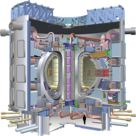Path planning for mobile robot missions in nuclear fusion scenarios of ITER

- Supervisor: Doutor Alberto Vale
- Co-Supervisor: Prof. Rodrigo Ventura
Framework
ITER-International Thermonuclear Experimental reactor is a joint international research and development project that aims to demonstrate the scientific and technical feasibility of fusion power (a safety source of energy with abundant fuel resources, to meet the needs of a growing world population). The ITER reactor is installed on a building (the Tokamak building) with dimensions equivalent to a football field and where the human beings are not allowed as soon as the operation starts. A Transfer Cask System (TCS) for the transportation of components during maintenance operations is required.
The TCS consists of an unshielded (with respect to gamma radiation) mobile vehicle with dimensions similar to an autobus with a maximum load of 100T and moved by air-cushion, provided with autonomous guidance and docking. This TCS must be able to travel between different pre-defined start/goals locations in different levels of the Tokamak building.
Objectives
Design a complete and optimized set of trajectories for the TCS to follow from all pairs of start/goal locations in the building. The optimization criteria should consider collision free and smooth paths with the minimization of steering maneuvers, and the preservation of a safe area around the vehicle. Additionally, it will maximize the length of the commons paths to be followed in different tasks, i.e., different pairs of start/goal locations.
Description
Development a module capable of receiving a 2D CAD model of the scenario and produce the optimal 2D paths that connect the set of start/goal locations. The optimization must consider the TCS specifications (kinematics and dynamics). The resulted paths must be graphically represented in a 2D plot with the respective velocities, accelerations and safety distance along each trajectory. The time duration and required energy must be estimated for each trajectory. Evaluation of the robustness of the optimal paths in different path following techniques should be addressed.
Related links
- Further information on RH in ITER: http://www.ipfn.ist.utl.pt/rh
- ITER - http://www.iter.org